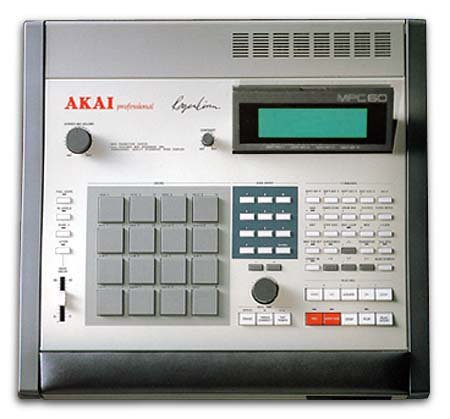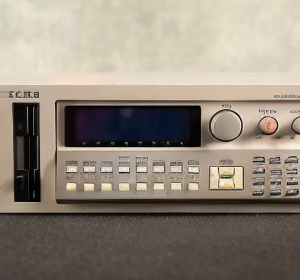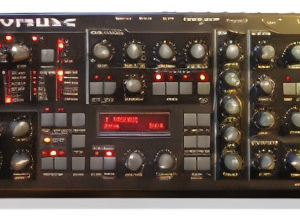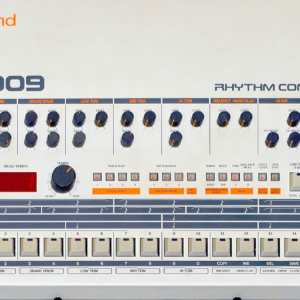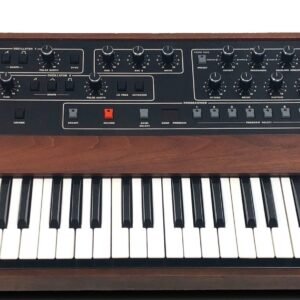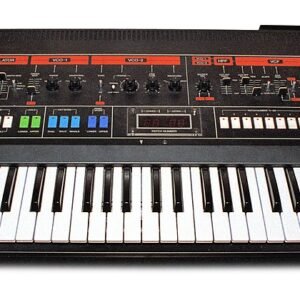Akai MPC 60
The Akai MPC 60 stands as an icon in the realm of electronic music production, revolutionizing the landscape with its innovative features and intuitive interface. Introduced in 1988, this classic drum machine and sampler combination quickly became a staple in studios worldwide, earning a reputation for its exceptional build quality, unparalleled sampling capabilities, and groundbreaking sequencing functions.
Designed by Roger Linn, the mastermind behind the legendary LinnDrum, the MPC 60 was a game-changer from the moment it hit the market. Its arrival signaled a shift in music production paradigms, offering musicians and producers a powerful tool that seamlessly integrated sampling, sequencing, and drum programming in a single, compact unit.
The MPC 60’s introduction marked a significant departure from traditional methods of music production, where sampling and sequencing were often disjointed processes requiring multiple pieces of equipment. With its all-in-one approach, the MPC 60 streamlined workflows, allowing artists to capture samples, sequence beats, and arrange entire tracks with unprecedented ease and efficiency.
In addition to its functional prowess, the MPC 60 also played a crucial role in shaping the sonic landscape of hip-hop, electronic, and dance music. Its signature sound, characterized by punchy drums, gritty samples, and tight sequencing, became synonymous with the golden era of rap and remains highly sought after by producers seeking that authentic ’90s vibe.
As we delve deeper into the design, features, and impact of the Akai MPC 60, we’ll uncover the innovations that propelled it to legendary status and explore its enduring legacy in the ever-evolving world of music production.
Design and Features
The design of the Akai MPC 60 reflects a blend of functionality, durability, and user-friendliness, making it a beloved instrument among producers and musicians alike. From its robust construction to its intuitive interface, every aspect of the MPC 60 was carefully crafted to enhance the creative process and withstand the rigors of professional use.
1. Build Quality: The MPC 60 boasts a rugged and sturdy build, featuring a metal chassis and high-quality controls that inspire confidence in its reliability. Its tank-like construction ensures longevity, making it a mainstay in studios for decades.
2. Interface: One of the defining features of the MPC 60 is its intuitive and ergonomic interface, which simplifies complex tasks without sacrificing depth or flexibility. The layout is thoughtfully designed, with dedicated buttons and knobs for key functions, allowing users to navigate effortlessly through its various modes and features.
3. Sampling Capabilities: At the heart of the MPC 60 lies its sampling engine, which revolutionized the way musicians capture and manipulate sounds. With its 12-bit sampling resolution and variable sample rates, ranging from 10 kHz to 40 kHz, the MPC 60 delivers a unique sonic character that is prized for its warmth and grit.
4. Sequencing: The MPC 60’s sequencing capabilities are equally impressive, offering a powerful yet intuitive platform for building beats and arranging music. Its step sequencer allows for precise control over timing and rhythm, while its grid-based interface simplifies the process of programming intricate patterns and sequences.
5. Pad Performance: Central to the MPC 60 experience are its iconic drum pads, renowned for their responsive feel and dynamic sensitivity. These pressure-sensitive pads enable expressive drumming and sample triggering, allowing users to inject nuance and personality into their performances.
6. Connectivity: The MPC 60 is equipped with a comprehensive array of connectivity options, including MIDI inputs and outputs, as well as individual audio outputs for each sound channel. This allows for seamless integration with external devices and enables complex routing and signal processing workflows.
7. Storage: In terms of storage, the MPC 60 initially relied on floppy disks for saving and loading samples and sequences. While this may seem outdated by today’s standards, it was groundbreaking at the time and contributed to the MPC 60’s reputation as a standalone music production workstation.
Overall, the design and features of the Akai MPC 60 embody a commitment to excellence and innovation, setting a new standard for drum machines and samplers that continues to influence music production to this day.
Sound Generation
The Akai MPC 60’s sound generation capabilities played a pivotal role in shaping its iconic status and enduring appeal. With its distinctive sound character and versatile sonic palette, the MPC 60 remains a favorite among producers seeking a classic, vintage vibe for their music.
1. Sampling: At the core of the MPC 60’s sound generation is its sampling engine, which allows users to capture and manipulate audio samples with unprecedented flexibility and precision. The MPC 60 offers sampling at a 12-bit resolution, imparting a characteristic warmth and grit to its sound that is highly prized by enthusiasts and purists alike.
2. Sample Manipulation: Once samples are loaded into the MPC 60, users have a wide range of tools at their disposal for manipulating and shaping the sound to their liking. From trimming and looping to pitch-shifting and time-stretching, the MPC 60 provides comprehensive editing capabilities that enable users to sculpt samples with ease and precision.
3. Filters and Effects: The MPC 60 features a built-in low-pass filter and resonance control, allowing users to sculpt the timbre of their samples with surgical precision. Additionally, the MPC 60 offers basic effects such as tuning, envelope shaping, and basic modulation, providing further opportunities for sound design and experimentation.
4. Drum Programming: One of the MPC 60’s strengths lies in its drum programming capabilities, which allow users to create intricate drum patterns and rhythms with ease. The MPC 60’s intuitive sequencer and responsive drum pads make it a favorite among beatmakers and electronic musicians, enabling dynamic and expressive performances.
5. Sound Character: Perhaps the most defining aspect of the MPC 60’s sound generation is its unique sonic character, characterized by its 12-bit resolution, analog circuitry, and signature signal path. The MPC 60 imparts a warmth, punch, and texture to samples that is difficult to replicate with modern digital samplers, contributing to its timeless appeal and cult status among producers.
In summary, the Akai MPC 60’s sound generation capabilities are a testament to its enduring legacy as a pioneering instrument in the world of electronic music production. From its sampling prowess to its distinctive sonic character, the MPC 60 continues to inspire musicians and producers across genres, cementing its place as a true icon in the history of music technology.
Technical Specifications
Here are the technical specifications for the Akai MPC 60:
1. Sampling:
Sampling Rate: Variable, 10 kHz to 40 kHz
Sample Resolution: 12-bit
Sample Editing: Trim, Loop, Time Stretch, Pitch Shift
Maximum Polyphony: 16 voices
2. Sequencing:
Sequencer Resolution: 96 ppq (parts per quarter note)
Maximum Sequences: 99
Maximum Tracks per Sequence: 64
Maximum Songs: 99
3. Display:
Screen Type: Backlit LCD
Display Size: 240 x 64 pixels
Display Functions: Track and sequence information, sample editing parameters, MIDI data
4. Connectivity:
MIDI: In, Out, Thru
Audio Inputs: 2 x 1/4″ TRS (stereo)
Audio Outputs: 8 x 1/4″ TRS (individual outputs for each sound channel)
Storage: 3.5″ Floppy Disk Drive
5. Physical:
Dimensions (W x D x H): 17.25″ x 13.75″ x 3.25″
Weight: Approximately 13 lbs (5.9 kg)
Power Supply: Internal, 100-120V AC, 50/60 Hz
6. Expansion:
Expansion Options: Optional SCSI interface for external storage devices
Memory Expansion: Optional RAM expansion board for increased sample memory
7. Operating System:
Operating System: MPC 60 OS (proprietary)
Software Updates: Flash ROM updates available for system enhancements and bug fixes
8. Compatibility:
Compatibility: Compatible with a wide range of MIDI controllers and external devices
These technical specifications highlight the Akai MPC 60’s capabilities as a versatile and powerful music production workstation. With its sampling, sequencing, and editing features, along with its robust connectivity options and expandability, the MPC 60 remains a highly regarded instrument among producers and musicians seeking a classic and reliable tool for their creative endeavors.
Performance and Workflow
The Akai MPC 60’s performance and workflow capabilities have been lauded by musicians and producers for decades, owing to its intuitive interface, responsive controls, and seamless integration of sampling, sequencing, and editing functions. Here’s a closer look at how the MPC 60 enhances the creative process and facilitates smooth, efficient music production:
1. Sampling Workflow:
Efficient Sampling: The MPC 60 streamlines the sampling process, allowing users to capture audio samples quickly and easily. With variable sampling rates and 12-bit resolution, users can achieve a desired balance between sound quality and memory usage.
Sample Editing: The MPC 60 offers comprehensive sample editing tools, including trimming, looping, time stretching, and pitch shifting. These features empower users to manipulate samples with precision, ensuring they fit seamlessly into their compositions.
2. Sequencing and Beat Programming:
Intuitive Sequencer: The MPC 60’s sequencer is renowned for its ease of use and flexibility. With a resolution of 96 ppq (parts per quarter note), users can create intricate patterns and sequences with precise timing and rhythm.
Real-Time Recording: The MPC 60 supports real-time recording, allowing users to capture performances directly into the sequencer. This enables spontaneous creativity and improvisation, giving users the freedom to experiment with different ideas and arrangements.
3. Drum Programming and Performance:
Responsive Drum Pads: The MPC 60 features iconic drum pads that are highly responsive and velocity-sensitive. This enables expressive drum programming and performance, allowing users to add dynamics and nuance to their beats.
Note Repeat and Swing: The MPC 60 offers note repeat and swing functions, which enhance the groove and feel of programmed sequences. These features add a human touch to the music, making it more lively and dynamic.
4. Workflow Optimization:
Dedicated Controls: The MPC 60’s interface is designed with dedicated controls for key functions, making it easy to navigate and operate. Users can access sampling, sequencing, editing, and mixing functions directly from the front panel, minimizing the need for complex menu diving.
Seamless Integration: The MPC 60 seamlessly integrates with external devices and software, thanks to its MIDI connectivity and compatibility with industry-standard file formats. This allows users to incorporate external instruments, effects, and controllers into their workflow, expanding their creative possibilities.
In summary, the Akai MPC 60’s performance and workflow capabilities are geared towards enhancing creativity, streamlining production, and empowering musicians and producers to realize their musical vision with precision and efficiency. Whether used in the studio or on stage, the MPC 60 remains a trusted tool for shaping sound and crafting compelling music.
Performance and Workflow
The Akai MPC 60’s performance and workflow capabilities have been lauded by musicians and producers for decades, owing to its intuitive interface, responsive controls, and seamless integration of sampling, sequencing, and editing functions. Here’s a closer look at how the MPC 60 enhances the creative process and facilitates smooth, efficient music production:
1. Sampling Workflow:
Efficient Sampling: The MPC 60 streamlines the sampling process, allowing users to capture audio samples quickly and easily. With variable sampling rates and 12-bit resolution, users can achieve a desired balance between sound quality and memory usage.
Sample Editing: The MPC 60 offers comprehensive sample editing tools, including trimming, looping, time stretching, and pitch shifting. These features empower users to manipulate samples with precision, ensuring they fit seamlessly into their compositions.
2. Sequencing and Beat Programming:
Intuitive Sequencer: The MPC 60’s sequencer is renowned for its ease of use and flexibility. With a resolution of 96 ppq (parts per quarter note), users can create intricate patterns and sequences with precise timing and rhythm.
Real-Time Recording: The MPC 60 supports real-time recording, allowing users to capture performances directly into the sequencer. This enables spontaneous creativity and improvisation, giving users the freedom to experiment with different ideas and arrangements.
3. Drum Programming and Performance:
Responsive Drum Pads: The MPC 60 features iconic drum pads that are highly responsive and velocity-sensitive. This enables expressive drum programming and performance, allowing users to add dynamics and nuance to their beats.
Note Repeat and Swing: The MPC 60 offers note repeat and swing functions, which enhance the groove and feel of programmed sequences. These features add a human touch to the music, making it more lively and dynamic.
4. Workflow Optimization:
Dedicated Controls: The MPC 60’s interface is designed with dedicated controls for key functions, making it easy to navigate and operate. Users can access sampling, sequencing, editing, and mixing functions directly from the front panel, minimizing the need for complex menu diving.
Seamless Integration: The MPC 60 seamlessly integrates with external devices and software, thanks to its MIDI connectivity and compatibility with industry-standard file formats. This allows users to incorporate external instruments, effects, and controllers into their workflow, expanding their creative possibilities.
In summary, the Akai MPC 60’s performance and workflow capabilities are geared towards enhancing creativity, streamlining production, and empowering musicians and producers to realize their musical vision with precision and efficiency. Whether used in the studio or on stage, the MPC 60 remains a trusted tool for shaping sound and crafting compelling music.
Notable Users and Influences
The Akai MPC 60 has left an indelible mark on the world of music, influencing generations of musicians, producers, and artists across a wide range of genres. From hip-hop and electronic music to pop and beyond, the MPC 60’s distinctive sound and intuitive workflow have captivated and inspired countless individuals. Here are some notable users and the impact of the MPC 60 on their music:
1. Dr. Dre:
Dr. Dre, the legendary hip-hop producer and artist, is synonymous with the MPC 60. He famously used the MPC 60 extensively in the production of seminal albums such as “The Chronic” and “2001,” shaping the sound of West Coast hip-hop and influencing a generation of producers.
2. J Dilla:
J Dilla, the visionary producer and beatmaker, is revered for his innovative use of the MPC 60. His soulful and intricate productions, characterized by off-kilter rhythms and soulful samples, have left an indelible mark on hip-hop and electronic music.
3. DJ Premier:
DJ Premier, one of the most influential producers in hip-hop history, is known for his mastery of the MPC 60. His iconic beats for artists such as Gang Starr, Nas, and Jay-Z showcase the MPC 60’s ability to create timeless grooves and gritty textures.
4. The Chemical Brothers:
The Chemical Brothers, pioneers of the electronic music scene, have long been advocates of the MPC 60. Their groundbreaking albums, such as “Dig Your Own Hole” and “Surrender,” feature hypnotic rhythms and infectious grooves crafted with the MPC 60’s sampling and sequencing capabilities.
5. Kanye West:
Kanye West, the innovative rapper, producer, and fashion mogul, has utilized the MPC 60 in various stages of his career. From his early productions on “The College Dropout” to his boundary-pushing albums like “Yeezus,” the MPC 60 has played a significant role in shaping Kanye’s distinct sound.
6. Aphex Twin:
Aphex Twin, the enigmatic electronic musician and producer, has employed the MPC 60 in his experimental and genre-defying compositions. His pioneering work in IDM (Intelligent Dance Music) and ambient music showcases the MPC 60’s versatility and creative potential.
7. The Neptunes:
The Neptunes, consisting of Pharrell Williams and Chad Hugo, are renowned for their innovative production style and chart-topping hits. The MPC 60 has been a staple in their studio setup, contributing to their signature sound and iconic collaborations with artists across genres.
8. Madlib:
Madlib, the prolific producer and rapper, is celebrated for his genre-blurring productions and sample-based compositions. His use of the MPC 60 in projects like “Madvillainy” and “Quasimoto” highlights its role as a cornerstone of his creative process.
In conclusion, the Akai MPC 60’s impact on music is undeniable, with its influence extending far beyond the confines of hip-hop and electronic music. From its role in shaping iconic albums to its contribution to the evolution of music production techniques, the MPC 60 continues to inspire and influence artists around the world, cementing its legacy as a true icon in the history of music technology.
Impact and Legacy
The Akai MPC 60’s impact and legacy in the world of music production are profound, reshaping the landscape of electronic music and leaving an indelible mark on generations of artists and producers. Its innovative features, distinctive sound, and intuitive workflow have propelled it to iconic status, with a lasting influence that continues to reverberate throughout the industry.
1. Revolutionizing Music Production:
The MPC 60 revolutionized music production by consolidating sampling, sequencing, and drum programming into a single, integrated workstation. This streamlined workflow empowered artists to create entire tracks from start to finish within a single device, eliminating the need for complex setups and cumbersome hardware.
2. Shaping Musical Genres:
The MPC 60 played a pivotal role in shaping the sound of numerous musical genres, particularly hip-hop, electronic, and dance music. Its distinctive sound character, characterized by punchy drums, gritty samples, and tight sequencing, became synonymous with the golden era of rap and continues to influence contemporary music styles.
3. Empowering Creativity:
The MPC 60’s intuitive interface and responsive controls empowered musicians and producers to unleash their creativity without technical barriers. Its real-time recording capabilities, expressive drum pads, and comprehensive sample editing tools gave artists the freedom to experiment, improvise, and express themselves with unparalleled spontaneity.
4. Pioneering Sampling Techniques:
The MPC 60 pioneered sampling techniques that have become standard practice in modern music production. Its variable sampling rates, sample manipulation capabilities, and extensive editing tools pushed the boundaries of what was possible with sampling technology, inspiring countless artists to explore new sonic territories.
5. Influencing Music Technology:
The MPC 60’s influence extends beyond its immediate impact on music production, shaping the trajectory of music technology as a whole. Its innovative features and groundbreaking design set a new standard for drum machines and samplers, paving the way for future advancements in hardware and software development.
6. Enduring Popularity and Cult Status:
Despite advances in technology, the MPC 60 remains highly sought after by musicians, collectors, and enthusiasts alike. Its timeless design, iconic sound, and legendary status have earned it a place of honor in studios around the world, ensuring its legacy lives on for generations to come.
In conclusion, the Akai MPC 60’s impact and legacy are undeniable, representing a landmark achievement in the history of music technology. From its role in shaping musical genres to its enduring popularity among artists, the MPC 60 continues to inspire and captivate audiences, solidifying its place as a true icon in the annals of music production.
Collector's Value and Market Trends
The Akai MPC 60 holds a special place in the hearts of musicians, producers, and collectors alike, commanding significant collector’s value and influencing market trends in the realm of vintage music gear. Its iconic status, legendary sound, and historical significance have contributed to its enduring popularity and increasing demand among enthusiasts. Here’s a closer look at the collector’s value and market trends associated with the MPC 60:
1. Vintage Appeal:
The MPC 60’s vintage appeal stems from its role as a groundbreaking instrument in the history of music production. As one of the first standalone sampling drum machines, it represents a pivotal moment in the evolution of electronic music technology, making it highly coveted among collectors and aficionados.
2. Limited Availability:
Due to its age and limited production run, the MPC 60 has become increasingly rare and difficult to find in good condition. This scarcity contributes to its collector’s value, driving up prices in the secondary market and prompting enthusiasts to seek out well-preserved units for their collections.
3. Iconic Sound:
The MPC 60’s distinctive sound character, characterized by its 12-bit sampling resolution and analog circuitry, remains highly sought after by producers seeking a vintage, lo-fi aesthetic. Its punchy drums, gritty samples, and warm textures have contributed to its cult status and enduring appeal among musicians.
4. Influence on Contemporary Music:
The MPC 60’s influence on contemporary music production continues to fuel its collector’s value and market demand. Artists and producers are drawn to its timeless sound and intuitive workflow, incorporating it into their setups to capture the authentic vibe of classic hip-hop and electronic music.
5. Rising Prices:
In recent years, prices for the MPC 60 have been on the rise, reflecting its growing popularity and collector’s appeal. Mint-condition units with original packaging and accessories command premium prices, while even used or refurbished models fetch significant sums due to their scarcity and historical significance.
6. Cultural Significance:
Beyond its technical specifications and market value, the MPC 60 holds cultural significance as an emblem of creativity, innovation, and artistic expression. Its presence in the studio symbolizes a connection to the roots of hip-hop and electronic music, inspiring a sense of nostalgia and reverence among musicians and fans.
In summary, the Akai MPC 60’s collector’s value and market trends underscore its status as a timeless icon in the world of music technology. As demand continues to rise and supply dwindles, the MPC 60 remains a prized possession for collectors and enthusiasts, embodying the spirit of innovation and creativity that defines the history of electronic music production.
Innovations and Contributions
The Akai MPC 60 stands as a testament to innovation in music technology, introducing groundbreaking features and setting new standards for electronic music production. Its contributions to the industry have had a profound and lasting impact, shaping the way music is created and inspiring generations of musicians and producers. Here are some key innovations and contributions of the MPC 60:
1. All-in-One Music Production Workstation:
The MPC 60 revolutionized music production by integrating sampling, sequencing, and drum programming into a single, standalone unit. This all-in-one approach streamlined workflows, eliminated the need for complex setups, and empowered artists to create entire tracks with unprecedented ease and efficiency.
2. Iconic Drum Pads:
The MPC 60 introduced the concept of velocity-sensitive drum pads, providing a tactile and expressive interface for drum programming and sample triggering. These iconic pads became a hallmark of the MPC series, setting a new standard for performance and playability in electronic music instruments.
3. Sampling Revolution:
The MPC 60 played a pivotal role in popularizing sampling as a fundamental technique in music production. Its advanced sampling capabilities, including variable sample rates and 12-bit resolution, opened up new creative possibilities and allowed artists to manipulate sounds in ways previously unimaginable.
4. Intuitive User Interface:
The MPC 60’s intuitive interface and ergonomic design made it accessible to musicians of all skill levels, democratizing music production and empowering individuals to express themselves creatively. Its straightforward layout, dedicated controls, and visual feedback simplified complex tasks and facilitated fluid workflows.
5. Timeless Sound Character:
The MPC 60’s distinctive sound character, characterized by its 12-bit sampling resolution and analog circuitry, has become synonymous with the golden era of hip-hop and electronic music. Its warm, gritty textures and punchy drums continue to inspire artists seeking a vintage, lo-fi aesthetic for their productions.
6. Influence on Music Culture:
The MPC 60’s influence extends far beyond its technical specifications, shaping the cultural landscape of music and influencing the way artists approach composition, production, and performance. Its iconic status in hip-hop culture, in particular, has cemented its place as a symbol of creativity, innovation, and artistic expression.
In summary, the Akai MPC 60’s innovations and contributions have left an indelible mark on the world of music technology, inspiring countless artists and shaping the evolution of electronic music production. Its legacy as a pioneering instrument continues to resonate with musicians and producers, reaffirming its status as a true icon in the history of music technology.
Conclusion
The Akai MPC 60 stands as a timeless icon in the realm of music production, embodying innovation, creativity, and artistic expression. From its pioneering features to its enduring legacy, the MPC 60 has left an indelible mark on the world of electronic music, shaping the way music is created, performed, and appreciated.
Throughout its illustrious history, the MPC 60 has revolutionized music production with its all-in-one approach, integrating sampling, sequencing, and drum programming into a single, intuitive workstation. Its iconic drum pads, advanced sampling capabilities, and intuitive user interface have empowered artists to unleash their creativity and push the boundaries of sonic experimentation.
Beyond its technical specifications, the MPC 60 holds a special place in the hearts of musicians, producers, and collectors worldwide. Its distinctive sound character, cultural significance, and timeless appeal continue to inspire generations of artists, reaffirming its status as a true legend in the annals of music technology.
As we reflect on the legacy of the Akai MPC 60, we celebrate its contributions to the evolution of electronic music and honor its enduring impact on music culture. From the streets of New York City to studios around the globe, the MPC 60’s influence reverberates through the rhythms of hip-hop, the textures of electronic music, and the melodies of countless musical genres.
In the ever-changing landscape of music technology, the MPC 60 remains a beacon of innovation, creativity, and inspiration, reminding us of the power of technology to transform ideas into art and shape the soundscape of the future. As we look to the horizon, we carry with us the spirit of the MPC 60—a symbol of possibility, ingenuity, and the relentless pursuit of musical excellence.
